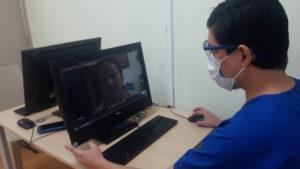Mainstreaming Telehealth During a Global Emergency

As traditional healthcare finds itself overwhelmed by the effects of COVID-19, telehealth is receiving more and more attention as potentially a key strategy to meet the challenge. Not only does telehealth hold the promise of nimbler and less expensive care, but it is ideal for fighting communicable diseases.
In a recent article for the Journal of Telemedicine and Telecare, PCHSS investigators Dr Centaine Snoswell and Associate Professor Liam Caffrey, along with colleagues, highlight how the current health crisis could be used as an inflection point for moving telehealth from the fringes of healthcare to part of “business as usual”. Published on 20 March 2020, “Telehealth for global emergencies: Implications for coronavirus disease 2019 (COVID-19)” outlines how telehealth has been used in other emergency situations in the past few decades, the barriers to greater telehealth uptake, and the potential for the practice in the current moment.
The authors give examples of telehealth being used in response to hurricanes Harvey and Irma in North America in 2017, as well as telemental health services offered in Australia to people affected by the 2019 bushfires. But despite its use in previous emergency situations, telehealth has not become a part of the regular practice of healthcare providers. In Australia, for example, while there have been generous financial incentives for specialist video-consultations, in 2014 telehealth accounted for less than 1% of all specialist consultations. Similarly, in the US, less than 1% of people living in rural areas have ever experienced telehealth.
The article cites several factors that have contributed to telehealth not having achieved wider adoption, among them clinician (un)willingness to participate in the practice, issues of financial reimbursement, and challenges related to the organisation of healthcare. For instance, it indicates that telehealth can be complex and requires clinicians to learn new methods of consulting. For it to be accepted, therefore, clinicians must be convinced that telehealth is effective, safe, and normal. As such, relying on “individual clinicians to lead telehealth is not a sustainable approach”, they say. Rather, telehealth adoption “requires a whole-system strategy.”
The authors further point out a unique issue at play in the current crisis—namely, that telehealth tends to focus on rural populations, but it is actually in cities that COVID-19 is spreading most rapidly:
For example, in Australia, funding is predominantly focused on medical consultations delivered by videoconference for patients in rural and remote locations. This is problematic because telehealth is just as useful for people living in metropolitan locations. In the case of COVID-19, city locations are most at risk because of greater population density. [This situation highlights] the importance of providing care via telehealth to non-infected people during an infectious pandemic. This can reduce contamination when it is necessary to see an infected patient in-person”.
This distinctive set of circumstances only reinforces the necessity of healthcare systems to more fully develop their telehealth capabilities to meet people’s needs, independent of geographic location. As the authors conclude: “It is important that the development of a telehealth strategy to deal with global and national emergency responses is built on the premise that telehealth becomes a mainstream component of our health system.”

